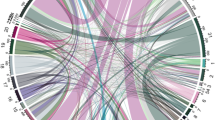Abstract
China in 2009 announced the binding target of its CO2 emissions in 2020: reduce its CO2 emission intensity by 40–45% relative to 2005. In this article, stocks and flows model is used to carry out substance flow analysis toward energy- and limestone-related carbons in China from 1991 to 2007. Then, the possible paths which China can take to achieve this target are presented and discussed in scenario analysis. It is found that (1) conversion into secondary energy, electricity and heat, and limestone calcinations contributed most to the ever-increasing carbon consumption of China during 1991–2007, (2) secondary industry is the biggest carbon consumer and emitter within Chinese economy, and the percentage of carbons emitted by households fell from 1991 to 2007, (3) CO2 emission intensities of three industries and China fell from 1991 to 2002, and then fluctuated during 2002–2007, and (4) both the adjustment in economic structure and the decline in secondary industry’s CO2 emission intensity can influence China’s CO2 emission intensity in an independent way. The emission target can be realized in 2020 when the former becomes 6%:40%:54% and meanwhile the latter decreases to 4.01 tons CO2/10,000 RMB in constant 2000 price. Finally, several policy suggestions are made.







Similar content being viewed by others
References
Cai WJ, Wang C, Wang K, Zhang Y, Chen JN (2007) Scenario analysis on CO2 emissions reduction potential in China’s electricity sector. Energy Policy 35(12):6445–6456
CESY (1992–2008) China Energy Statistical Yearbook, National Bureau of Statistics of China, National Development and Reform Commission (NDRC), Beijing, China
Consultative Report for Chinese Academy of Engineering (CRCAE) (2008) The assessment and countermeasure Research of CO2 emissions from iron and steel industry, chemical industry, petrochemical industry and cement industry. Chin Acad Eng, Beijing
CSY (1992–2008) China Statistical Yearbook, National Bureau of Statistics of China, Beijing, China
EIA (2009) International Energy Outlook 2009. Energy Information Administration, Washington D.C
Fan Y, Liu LC, Wu G, Tsai HT, Wei YM (2007) Changes in carbon intensity in China: empirical findings from 1980–2003. Ecol Econ 62(3–4):683–691
IEA (2004) Key world energy statistics. International Energy Agency, Paris
IEA (2009) CO2 emissions from fuel combustion 2009 edition. International Energy Agency, Paris
IPCC (2006) IPCC guidelines for national greenhouse gas inventories. Intergovernmental panel on climate change
Jin G (2007) Taiwan’s experience in industrial structure change and its implication for Zhejiang. Technol Econ 26(12):60–65 (in Chinese)
Li ZD (2010) Quantitative analysis of sustainable energy strategies in China. Energy Policy 38(5):2149–2160
National Development and Reform Commission (NDRC) (2004) Medium and long-term development plan for energy saving in China (2005–2020). NDCR, Beijing
National Development and Reform Commission (NDRC) (2007a) Medium and long-term development plan for renewable energy in China (2005–2020). NDCR, Beijing
National Development and Reform Commission (NDRC) (2007b) Medium and long-term development plan for nuclear power generation in China (2005–2020). NDRC, Beijing
Paul S, Bhattacharya RN (2004) CO2 emissions from energy use in India: a decomposition analysis. Energy Policy 32(5):585–593
Southmoney (2009) China is going to adjust its medium and long-term development plan for nuclear power generation. http://www.southmoney.com/hangqing/dongtai/94213.html. Accessed 27 June 2010
Wang T, Watson J (2010) Scenario analysis of China’s emissions pathways in the 21st century for low carbon transition. Energy Policy 38(7):3537–3546
Wang C, Chen JN, Zou J (2005) Decomposition of energy-related CO2 emission in China: 1957–2000. Energy 30(1):73–83
Wu LB, Kaneko S, Matsuoka S (2005) Driving forces behind the stagnancy of China’s energy-related CO2 emissions from 1996 to 1999: the relative importance of structural change, intensity change and scale change. Energy Policy 33(3):319–335
Xinhuanet (2010) The percentage of employers in tertiary industry of China is less than that of developed countries by more than 30%. http://news.qq.com/a/20100306/002441.htm. Accessed 20 Aug 2010
Zhang B (2009) Scenario analyses of china’s energy and power use and carbon emission in 2020. Energy Environ 31(3):28–31 (in Chinese)
Zhang M, Mu HL, Ning YD (2009) Accounting for energy-related CO2 emission in China, 1991–1996. Energy Policy 37(3):767–773
Zhao XL, Ma CB, Hong DY (2010) Why did China’s energy intensity increase during 1998–2006: decomposition and policy analysis. Energy Policy 38(3):1379–1388
Zhu B, Zhou WJ, Hu SY, Li Q, Brown CG, Jin Y (2010) CO2 emissions and reduction potential in China’s chemical industry. Energy 35(12):4663–4670
Author information
Authors and Affiliations
Corresponding author
Rights and permissions
About this article
Cite this article
Ma, D., Hu, S., Zhu, B. et al. Carbon substance flow analysis and CO2 emission scenario analysis for China. Clean Techn Environ Policy 14, 815–825 (2012). https://doi.org/10.1007/s10098-012-0452-y
Received:
Accepted:
Published:
Issue Date:
DOI: https://doi.org/10.1007/s10098-012-0452-y




